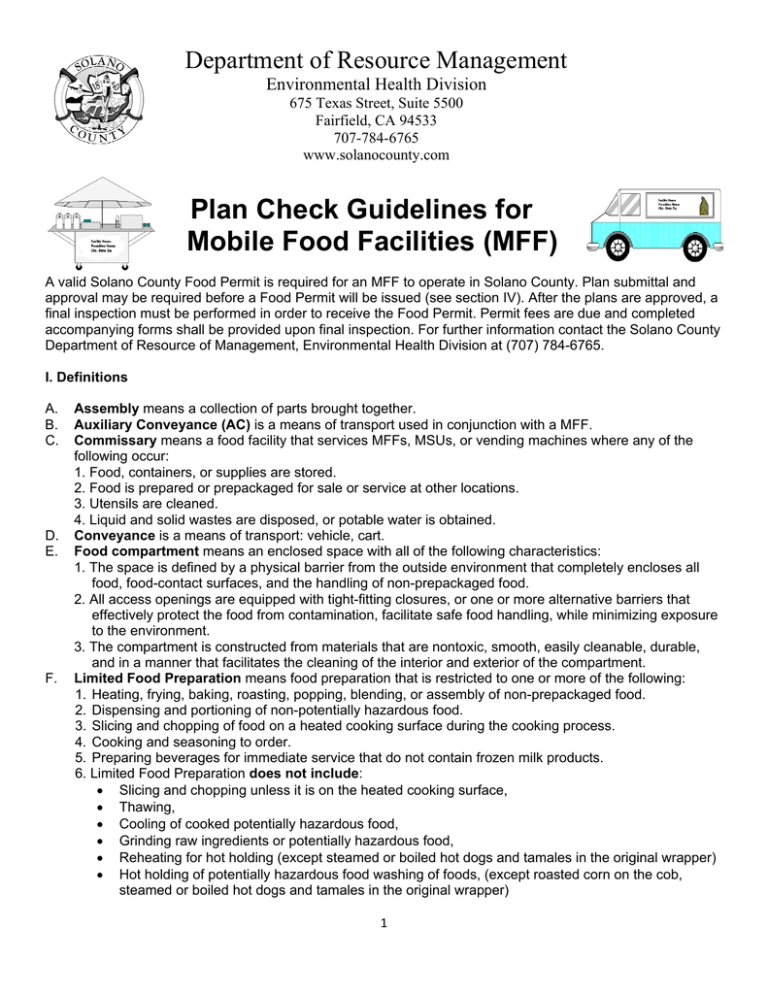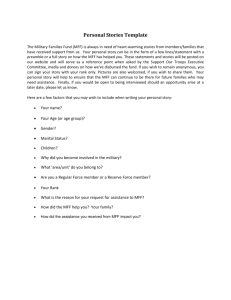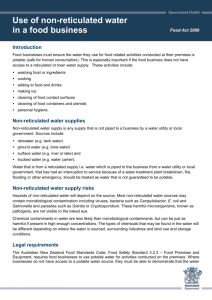Plan Check Guidelines for Mobile Food Facilities
advertisement

Department of Resource Management Environmental Health Division 675 Texas Street, Suite 5500 Fairfield, CA 94533 707-784-6765 www.solanocounty.com Plan Check Guidelines for Mobile Food Facilities (MFF) A valid Solano County Food Permit is required for an MFF to operate in Solano County. Plan submittal and approval may be required before a Food Permit will be issued (see section IV). After the plans are approved, a final inspection must be performed in order to receive the Food Permit. Permit fees are due and completed accompanying forms shall be provided upon final inspection. For further information contact the Solano County Department of Resource of Management, Environmental Health Division at (707) 784-6765. I. Definitions A. B. C. D. E. F. Assembly means a collection of parts brought together. Auxiliary Conveyance (AC) is a means of transport used in conjunction with a MFF. Commissary means a food facility that services MFFs, MSUs, or vending machines where any of the following occur: 1. Food, containers, or supplies are stored. 2. Food is prepared or prepackaged for sale or service at other locations. 3. Utensils are cleaned. 4. Liquid and solid wastes are disposed, or potable water is obtained. Conveyance is a means of transport: vehicle, cart. Food compartment means an enclosed space with all of the following characteristics: 1. The space is defined by a physical barrier from the outside environment that completely encloses all food, food-contact surfaces, and the handling of non-prepackaged food. 2. All access openings are equipped with tight-fitting closures, or one or more alternative barriers that effectively protect the food from contamination, facilitate safe food handling, while minimizing exposure to the environment. 3. The compartment is constructed from materials that are nontoxic, smooth, easily cleanable, durable, and in a manner that facilitates the cleaning of the interior and exterior of the compartment. Limited Food Preparation means food preparation that is restricted to one or more of the following: 1. Heating, frying, baking, roasting, popping, blending, or assembly of non-prepackaged food. 2. Dispensing and portioning of non-potentially hazardous food. 3. Slicing and chopping of food on a heated cooking surface during the cooking process. 4. Cooking and seasoning to order. 5. Preparing beverages for immediate service that do not contain frozen milk products. 6. Limited Food Preparation does not include: Slicing and chopping unless it is on the heated cooking surface, Thawing, Cooling of cooked potentially hazardous food, Grinding raw ingredients or potentially hazardous food, Reheating for hot holding (except steamed or boiled hot dogs and tamales in the original wrapper) Hot holding of potentially hazardous food washing of foods, (except roasted corn on the cob, steamed or boiled hot dogs and tamales in the original wrapper) 1 Washing of foods Cooking of potentially hazardous foods for later use G. Mobile Food Facility (MFF) means any vehicle used in conjunction with a commissary or other permanent food facility upon which food is sold or distributed at retail. "Mobile food facility" does not include a "transporter" used to transport packaged food from a food facility, or other approved source to the consumer. H. Mobile Support Unit (MSU) means a vehicle, used in conjunction with a commissary that travels to and services MFFs as needed to replenish supplies, including food and potable water, clean the interior of the unit, or dispose of liquid or solid wastes. I. Occupied Mobile Food Facility (OMFF) means a fully enclosed MFF that is occupied during normal business operations. All food preparation other than Limited Food Preparation must be within an OMFF. J. Portable means equipment that is capable of being lifted and moved or has utility connections that are designed to be disconnected or of sufficient length to permit the unit to be moved for cleaning, and does not exceed 80 pounds (36 kg) in weight. K. Portioning means dividing into portions: abstracting from a whole. L. Prepackaged food means any properly labeled processed food, prepackaged to prevent any direct human contact with the food product upon distribution from the manufacturer, and prepared at an approved source. M. Refrigeration unit means a mechanical unit that extracts heat from an area through liquefaction and evaporation of a fluid by a compressor, flame, or thermoelectric device, and includes a mechanical thermostatic control device that regulates refrigerated air blown into an enclosed area at or below the minimum required food storage temperature of potentially hazardous foods N. Tight-fitting means fabricated so that joining members are in contact along the entire seam with no opening greater than 1/64th inch (0.04 cm) O. Transporter means any vehicle used to transport food pursuant to a prior order from a manufacturer, distributor, retail food facility, or other approved source to a retail food facility. P. Vehicle means a method of carrying or transporting something conveyance. II. Operation From a Commissary-Cleaning and Servicing A. MFFs shall operate in conjunction with a commissary, MSU, or other facility approved by the enforcement agency. B. MFFs shall be stored at or within a commissary or other location approved by the enforcement agency in order to have protection from unsanitary conditions. C. MSUs shall be operated from and stored at a designated commissary and shall be subject to permitting and plan review. MSUs shall report to a commissary or other approved facility for cleaning, servicing, and storage at least daily. D. Unless serviced by an MSU, or operating at a community event, MFFs shall report to the commissary or other approved facility on a daily basis. MFFs shall be cleaned and serviced at least once daily during an operating day III. Employee Knowledge A. MFFs that prepare, handle, or serve non-prepackaged potentially hazardous food shall have an owner or employee who has successfully passed an approved and accredited food safety certification exam. No person can act as the certified person at more than one food facility. B. Each food handler shall maintain a valid food handler card for the duration of their employment. IV. Plan Submission A. Two sets of plans are required for any new or remodeled MFFor MSU prior to construction, or for facilities acquired by the operator in the finished state. Plans may also be required for a change in menu on an MFF that is presently permitted. MFFs or MSUs that have been previously permitted by this Division may be approved without plans as deemed appropriate. 2 B. Complete and easily readable plans shall be drawn to scale. Drawings shall include all applicable information listed on the Mobile Food Facility Plan Submittal Application. C. The following items shall be provided upon or prior to the final inspection: 1. Completed Commissary Agreement form 2. Operational procedures for food handling and the cleaning and sanitizing of food contact surfaces, food equipment and utensils (unenclosed food facility) 3. Operational procedures for the cleaning and sanitizing of the potable water tank (if tank is not accessible for inspection). V. Construction Requirements A. B. C. D. E. F. Surface materials of the MFF shall be constructed of a smooth, durable, washable, impervious material capable of withstanding frequent cleaning, free of cracks, seams, or linings where vermin may harbor. Unfinished wood is not permitted. Construction joints shall be tightly fitted and sealed with no gaps or voids. All sealant, solder and weld joints located in the food contact areas shall be smooth, and approved for food contact surfaces. Spaces around pipes, conduits or hoses that extend through cabinets, floors or outer walls shall be sealed to be smooth and easily cleanable. All food-related equipment and plumbing, including pumps, accumulators and filters shall be certified or classified for sanitation by an American National Standards Institute (ANSI) accredited certification program, i.e. National Sanitation Foundation (NSF), Intertek Testing Services (ITS or ETL), Underwriter’s Laboratory Sanitation (EPH), Canadian Standards Association CSA or other ANSI approved certification agency. In the absence of applicable ANSI sanitation certification, the equipment design, construction and installation is subject to approval by this Division. All food related fixtures, tanks, equipment, plumbing, pumps and filters must meet standards referenced in the current plumbing code. Plumbing fixtures, pumps and filters shall be installed according to the manufacturer’s specifications. .Equipment set apart from adjacent equipment, or the clearance between the top of the counter and the bottom of a piece of equipment with a rigid utility connection shall have a minimum gap of 4 inches of unobstructed space to facilitate cleaning. Equipment that can be easily moved by one person and has a flex connection need not comply with the above requirement for 4 inch clear space, but must also meet the definition of portable. All non-portable equipment shall be attached to the primary MFF. Electrical appliances shall meet applicable Underwriter’s Laboratory standards. G. Potable water tanks and plumbing: 1. 2. 3. 4. 5. 6. 7. 8. 9. Water tanks and plumbing shall be constructed of food grade material as approved by an ANSI accredited testing organization for drinking water. Interiors shall be smooth and free of recesses and crevices and capable of draining completely. Tanks shall be adequately vented for flow. Water tank vents shall terminate in a downward direction and shall be covered with 16 mesh per square inch screen or equivalent when the vent is in a protected area, or a protective filter when the vent is in an area not protected from windblown dirt and debris. Potable water tanks shall be sufficient in volume to fulfill the required 5-gallon minimum for hand washing. Facilities with limited food preparation must provide at least 15 additional gallons of water for ware washing and food preparation. For any preparation beyond limited food preparation, at least 25 additional gallons of water for ware washing and food preparation must be provided. Water tank capacities may be satisfied with one or more potable water tanks. Potable water inlets shall be protected from contamination and designed to preclude attachment to a non-potable service connection, e.g. quick disconnect. Potable water inlets shall be located at least 1 inch above the overflow. Overflow pipe openings shall be protected from the entrance of dust, insects and other contamination. Potable water tanks may be removable, but can be no greater in size than 10 gallons (80 lbs.) to be 3 considered suitably portable. 10. Connections to the potable water and waste tanks shall be of a different type or size so as to eliminate contamination of the potable water supply. Waste and potable water hose connections shall not be interchangeable. 11. Liquid waste hoses shall not be the same color as the hoses used for potable water. 12. If tanks are removable they should labeled “potable” or “waste”. H. Hand washing Sink*: 1. Shall be a minimum size of 9”x9”x5” in depth. 2. Shall be located on the operator side of the MFF or auxiliary conveyance and shall be unobstructed and easily accessible. The sink can be on the countertop or below a countertop cutaway extending at least halfway from the edge of the sink to the faucet handles. 3. Shall have hot and cold water through a mixing faucet capable of delivering a minimum of one gallon/minute. 4. Shall provide water at a minimum temperature of 100 degrees Fahrenheit and be tempered so as to prevent scalding. 5. Shall be provided with hand washing cleanser and single-use paper towels in dispensers at or adjacent to the hand sink. *MFFs limited to handling prepackaged foods, whole fish, whole aquatic invertebrates or bulk dispensing of non-potentially hazardous beverages do not require a handwash sink. I. Ware washing Sink: 1. MFFs where non-prepackaged food is cooked, blended, or otherwise prepared shall provide a ware washing sink with at least three compartments with two integral metal drain boards. 2. The ware washing sink shall be an integral part of the primary MFF unit or on an approved auxiliary conveyance, which shall include all of the utility connections. 3. Each compartment of the ware washing sink shall be large enough to accommodate the largest utensil and have minimum dimensions of 12” wide by 12” long by 10” deep (or 10”x14”x10”). 4. Each drain board shall be at least the size of one of the sink compartments. The drain boards shall be installed with at least one-eighth inch per foot slope toward the sink compartment, and fabricated with a minimum of one-half inch lip or rim to prevent the draining liquid from spilling onto the floor. 5. The sink shall be equipped with a mixing faucet and shall be provided with a swivel spigot capable of servicing all sink compartments. 6. A ware washing sink must provide water at a minimum temperature of 120 degrees Fahrenheit through a mixing faucet. 7. A water heater or an instantaneous heater capable of heating water to a minimum of 120 degrees Fahrenheit, interconnected with a potable water supply, shall be provided and shall operate independently of the vehicle engine. A water heater with a minimum capacity of three gallons shall be provided for MFFs conducting food preparation. A water heater with a minimum capacity of one-half gallon is required for MFFs that conduct only limited food preparation and no ware washing. 8. The ware washing sink (of unenclosed MFFs) shall be equipped with overhead protection made of wood, canvas, or other materials that protect it from contamination. 9. The hand washing sink shall be separated from the ware washing sink by a metal splashguard with a height of at least 6 inches or by a distance of at least 24 inches *MFFs that handle steamed/boiled hot dogs, tamales in the original wrapper or non-potentially hazardous foods that require no preparation other than heating, baking, popping, portioning, bulk dispensing, or assembly or shaving of ice are not required to provide a ware washing sink if all utensils and equipment are washed and sanitized on a daily basis at the approved commissary and an 4 adequate supply of spare preparation and serving utensils are maintained in the MFF to replace those that become soiled or contaminated. J. Gas fired appliances: 1. Thermocouples shall have a safety shut off device. 2. Propane tanks: That are enclosed within the MFF shall have at least two ventilation openings on opposite sides at the cylinder valve level and at least one ventilation opening required at the floor level. Each opening shall be a minimum of 10 square inches, screened with a minimum 16 mesh and shall vent to the exterior of the MFF. Enclosures shall be free of any source of ignition. Shall be securely placed and should not be located on the bumper of a trailer mounted vehicle. The only appropriate placement on the exterior of the MFF is on the front (tongue) of the trailer. Shall have a safety shut off valve. 3. All gas-fired appliances shall be properly insulated in a manner that will prevent excessive heat buildup and injury. 4. Certification shall be indicated by a decal on the appliance. 5. All new and replacement gas-fired appliances shall meet applicable ANSI standards. 6. All liquefied petroleum equipment shall be installed to meet applicable fire authority standards, and this installation shall be approved by the fire authority. K. Food compartment(s): 1. A compartment shall fully enclose and protect food contact surfaces, equipment and all handling of unpackaged food. All food processing must remain within a food compartment. 2. Tight-fitting doors to the compartment shall be required to allow complete enclosure during transport and non-operation of the MFF and during operating hours whenever food preparation and service is not occurring. 3. Food compartment shall be free of electrical or plumbing lines with the exception of those lines providing product supply water. 4. The food compartment interior shall have a smooth and cleanable surface. 5. Ice bins holding edible ice shall be placed within a compartment and shall be designed for easy access. 6. Food preparation counters shall be within the compartment, provide adequate space for food preparation and shall be constructed of food grade material. 7. Food compartment shall be vented to remove excess heat or steam as necessary. Ventilation shall be vermin proof. L. Wastewater Tanks: 1. All waste lines shall be connected to wastewater tanks with watertight seals. 2. Any wastewater tank mounted within an MFF or MSU shall have an air vent overflow provided in a manner that will prevent potential flooding of the interior of the facility. 3. A water tank vent shall terminate in a downward direction and shall be covered with 16 mesh per square inch screen or equivalent when the vent is in a protected area, or a protective filter when the vent is in an area that is not protected from windblown dirt and debris. 4. Wastewater tanks shall have a minimum capacity that is 50% greater than the total volume of the potable water tanks and in no case shall be less than 7.5 gallons. (e.g., A MFF with a 20 gallon water tank requires a minimum 30 gallon wastewater tank). Where ice is utilized an additional wastewater tank shall be provided with a capacity of at least 1/3 of the volume of the ice storage cabinet. 5. Wastewater tanks may be removable for easy disposal of waste, but cannot exceed 10 gallons (80 lbs.) to be considered portable. 6. Wastewater tanks shall have a discharge valve located to facilitate complete draining of the tank. 5 7. Removable tanks shall be labeled ‘potable’ or ‘waste’ M. Ventilation: 1. Mechanical exhaust ventilation equipment shall be provided over all cooking equipment as required to effectively remove cooking odors, smoke, steam, grease, heat, and vapors. 2. All mechanical exhaust ventilation equipment shall be installed and maintained in accordance with the Uniform Mechanical Code (UMC), or for OMFFs, certified and approved by HCD. 3. For UMC compliance the following shall be kept in good working order: Cooking equipment Hoods Ducts (if applicable) Fans Fire suppression systems Special effluent or energy control equipment N. Flooring: 1. Ground or floor surfaces where cooking processes are conducted from a grill, barbecue, or other unenclosed cooking unit on an MFF shall be impervious, smooth, easily cleanable, and shall provide employee safety from slipping. Ground or floor surfaces shall extend a minimum of five feet on all open sides of where cooking processes are conducted. O. Safety: 1. All pressure cylinders shall be securely fastened to a rigid structure. 2. A first-aid kit shall be provided and located in a convenient area in an enclosed case. 3. MFFs that operate at more than one location in a calendar day shall be equipped to meet all of the following requirements: All utensils in an MFF shall be stored so as to prevent their being thrown about in the event of a sudden stop, collision, or overturn. A safety knife holder shall be provided to avoid loose storage of knives in cabinets, boxes, or slots along counter aisles. Knife holders shall be designed to be easily cleanable and be manufactured of materials approved by the enforcement agency. Coffee urns, deep fat fryers, steam tables, and similar equipment shall be equipped with positive closing lids that are fitted with a secure latch mechanism that will prevent excessive spillage of hot liquids into the interior of an MFF in the event of a sudden stop, collision, or overturn. As an alternative to this requirement, a coffee urn may be installed in a compartment that will prevent excessive spillage of coffee in the interior of the unit. Metal protective devices shall be installed on the glass liquid level sight gauges on all coffee urns 4. Light bulbs and tubes shall be covered with a completely enclosed plastic safety shield or equivalent, and be installed so as to not constitute a hazard to personnel or food. 5. All liquefied petroleum equipment shall be installed to meet applicable fire authority standards, and this installation shall be approved by the fire authority. However, units subject to HCD certification shall comply with HCD requirements. 6. A properly charged and maintained minimum 10 BC-rated fire extinguisher to combat grease fires shall be properly mounted and readily accessible on each MFF with heating elements or cooking equipment. 7. All gas-fired appliances shall be properly insulated in a manner that will prevent excessive heat buildup and injury. 6 VI. Fully Enclosed/Occupied Mobile Food Facilities (OMFF) In addition to the above requirements for MFFs, the following apply to OMFFs: A. California Department of Housing and Community Development (HCD) Certification: 1. If the OMFF has 110 volt electrical, plumbing, a gas appliance/equipment, or a mechanical generator or compressor, it must have a certification insignia issued by the California Department of Housing & Community Development. Contact HCD at (510)719-6788 for the requirements to obtain certification. B. Exterior requirements: 1. Entrance doors to food preparation area and service openings shall be self-closing. 2. Food service openings: Shall be no more than 216 square inches and no less than 18 inches apart. Shall be covered with solid material or screen. If screen is used it must be at least 16 mesh per inch. This section shall not apply to MFFs that are limited to the handling of prepackaged food and whole produce. 3. Compressor units that are not an integral part of the MFF shall be installed in an area separate from the food prep and storage areas. 4. Propane tanks shall be located outside the MFF. There can be no other attachments on the exterior of the MFF (e.g., can opener). C. Interior requirements: 1. OMFFs shall have a clear, unobstructed height over the aisle-way portion of the unit of at least 74 inches from floor to ceiling, and a minimum of 30 inches of unobstructed horizontal aisle space. 2. Walls and ceilings shall be constructed so surfaces are impervious, smooth and cleanable. 3. Floors shall be constructed of approved materials. The floor/wall juncture shall be coved with a minimum 3/8 inch radius and the floor surface shall extend up the wall at least four inches. (Vinyl rubber top-set base is not acceptable material). Equipment shall be sealed to the floor or raised 6 inches off of the floor by means of an easily cleanable leg and foot. This section shall not apply to MFFs that are limited to the handling of prepackaged food and whole produce, unless water flushing of floors is required. If water flushing of floors is required, a food grade hose shall be installed and maintained in an enclosed compartment. The food grade hose shall be of sufficient length to clean the interior of the vehicle. 7




